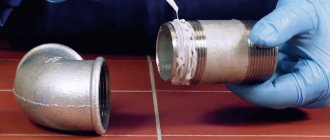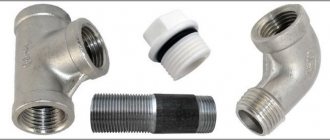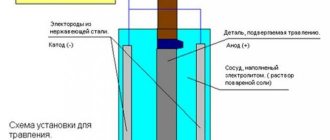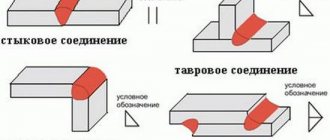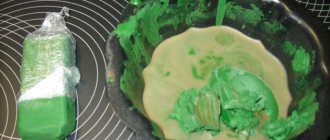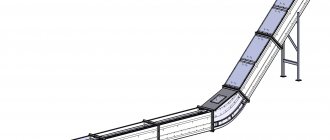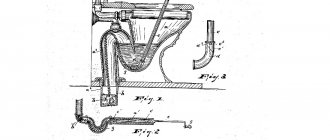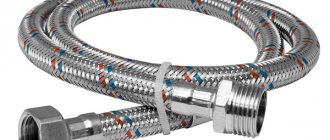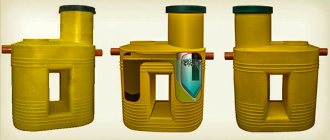The thread locker helps to increase the clamping force between screwed connections, that is, to prevent spontaneous unwinding, and also to protect the connecting parts from rust and sticking.
There are three main types of retainers available - red, blue and green. Reds are traditionally considered the “strongest” and greens the “weakest”. However, when choosing a particular fixative, you need to pay attention not only to the color, but also to the performance characteristics given on their packaging.
The strength of the fixation may depend not only on the color, but also on the manufacturer. Therefore, the end consumer has a reasonable question: which thread locker to choose? And to help you make your choice, here is a list of popular products, which was compiled based on reviews, tests and studies found on the Internet. As well as a description of the characteristics, composition and selection principle.
Why use thread lockers?
Thread lockers are widespread not only in the automotive industry, but also in other areas of production. These tools have replaced the “old-fashioned” methods of fixing threaded connections, such as a groover, a polymer insert, a bend washer, a lock nut and other delights.
The reason for using these technological means is that modern cars increasingly use threaded connections with a fixed (optimal) tightening torque, as well as bolts with an increased bearing surface. It is therefore important to maintain the downforce value throughout the life of the assembly.
Thus, thread lockers are used when fastening brake calipers, camshaft pulleys, in the design and fastening of the gearbox, in steering controls, and so on. Clamps are used not only in automotive technology, but also when performing other repair work. For example, when repairing household appliances, bicycles, gas and electric saws, scythes and other equipment.
Anaerobic thread lockers not only perform their direct function of fixing the connection of two parts, but also protect their surfaces from oxidation (rusting), and also seal them. Therefore, it makes sense to use thread lockers to adequately protect parts in places where there is a high probability of moisture and/or dirt getting into the threads.
How to use thread locker?
The principle of operation of this glue and the method of its use can be analyzed using the example of one of the tests of this anaerobic fixative. For the experiment, a fastening element is prepared, the thread of which is M10 × 1.25 (nuts and bolts). For all products being tested, a bolt is taken with a nut already screwed onto it. The bolts must first be cleaned and degreased. Then you need to treat the threaded part of the bolt with a clamp, and then screw the second nut onto it. The latter should have a small fixed tightening torque. The tightening should not be too tight. Otherwise, it will affect the test results. And its ultimate goal is to record the moment of unscrewing. This way the effect of the fixatives is exclusively tested. After a day at room temperature, all connections must be clamped one by one on a stationary frame so that only the top nut is captured by the head of the torque wrench. 5 Nm is the value of the initial moment. This is less than 10% of the maximum tightening torque of such fasteners. If the connection copes with the given force, a sequential increase in torque is allowed using 5 Nm steps. The quality of the fastener being tested is assessed according to the following pattern: if the threaded connection unscrews at a very high torque, then the fastener is of high quality and is worth using:
- for brake calipers;
- in the gearbox;
- in the steering mechanism.
Types of thread lockers
Despite all the variety of thread lockers, they can all be divided into three broad categories - red, blue and green. This division by color is very arbitrary, but it still gives a basic understanding of how high-strength or, conversely, weak the sealant is offered.
Red fasteners are traditionally considered the most “strong”, and are positioned by manufacturers as highly durable. Most of them are heat-resistant, that is, those that can be used in mechanisms, including automobile ones, operating at temperatures above +100°C (usually up to +300°C). The definition of “one-piece”, often applied specifically to red thread lockers, is rather a marketing ploy. Real tests show that threaded connections treated with even the most “durable” means are quite amenable to dismantling using plumbing tools.
Blue thread lockers are usually positioned . That is, their strength is somewhat less than that of the red ones (medium strength).
Green clamps are the weakest. They can also be described as “dismantled”. They are usually used for processing threaded connections of small diameter, and screwed with low torque.
The following categories into which threaded fasteners are divided are operating temperature range . As a rule, conventional and high-temperature agents are distinguished. As their names suggest, fasteners can be used to secure threaded connections that operate at different temperatures.
Threaded fasteners are also divided according to their state of aggregation. liquid and paste are available on sale . Liquid locking agents are typically used for small threaded connections. And the larger the threaded connection, the thicker the product should be. In particular, for large threaded connections, fasteners in the form of a thick paste are used.
Most threadlockers are anaerobic. This means that they are stored in a tube (vessel) in the presence of air, and under such conditions they do not enter into a chemical reaction and do not manifest themselves in any way. However, after they are applied to the surface to be treated, in conditions where air access to them is limited (when the thread is tightened), they polymerize (that is, harden), and perform their direct function, which is to reliably fix two contacting surfaces. It is for this reason that most tubes of fixatives feel soft to the touch and appear to be more than half full of air.
Often, polymerizing agents are used not only for locking threaded connections, but also for sealing welds, sealing flange joints, and gluing products with flat surfaces. A classic example in this case is the famous “Super Glue”.
Composition of thread locker
The basis of most anaerobic dismountable (detachable) thread lockers is polyglycol methacrylate, as well as modifying additives. More complex (one-piece) products have a more complex composition. For example, the “Abro” fixative is red and has the following composition: acrylic acid, alpha dimethylbenzyl hydroperoxide, bisphenol A ethoxyl dimethacrylate, dimethacrylate ester, 2-hydroxypropyl methacrylate.
However, color gradation is just a rough approximation across product categories, and when choosing a particular fixative, you always need to pay attention to two factors. The first is the performance characteristics of the selected retainer. The second is the size of the parts being processed (threaded connections), as well as the material from which they are made.
We compare threaded fasteners from different manufacturers
In terms of composition, any thread locker consists of the same components. When you go to a specialized store, you will see a lot of offers: “Permatex”, “Abro”, “Loctite”, “Wurth”.
Almost all manufacturers of automotive chemicals have these sealants in their product range. Why, with the same declared characteristics, does a tube of a good fixative (according to the sellers) have a different price?
The most expensive segment is sealants used by automakers. Permatex compounds are used for permanent connections. On the conveyor belt, the glue is packaged in barrels, but exactly the same product is offered on the shelves in small containers. Manufacturer Abro offers economical prices . This does not mean that sealants with this logo are of low quality, just that the chemical concern has organized mass production in various countries, which reduces production costs. The blue composition of this brand is used not only as a thread locker, but also as a sealant for sealing defects in welds.
Loctite 270 has gained popularity among car enthusiasts due to its resistance to petroleum products. The chemical composition allows it to be applied to lightly soiled surfaces. Special additives enhance adhesion when processing neutral surfaces: stainless steel, galvanized, anodized coatings, aluminum.
Video review of the most popular thread lockers
How to Choose the Best Thread Locker
In addition to color, there are a number of criteria that you must pay attention to when choosing a particular thread lock. Below they are listed in order.
Fixed moment of resistance
Torque value indicated as "one-piece". Unfortunately, most manufacturers do not indicate this specific value. Others indicate the moment of resistance with specific values. However, the problem here is that the manufacturer does not say what size threaded connection this resistance is designed for.
Obviously, to unscrew a small bolt, less torque is needed than to unscrew a bolt with a large diameter. There is an opinion among car enthusiasts that “you can’t spoil porridge with oil,” that is, the stronger the retainer you use, the better. However, it is not! If you use a very strong lock on a small bolt with fine threads, it can be permanently tightened, which is not desirable in most cases. At the same time, a similar composition will be the less effective the larger the thread (both diameter and length) it is used for.
Interestingly, different manufacturers indicate the viscosity value of their product in different units of measurement. In particular, some indicate this value in centiPoise, [cP] - a unit of dynamic viscosity in the GHS system of units (this is usually what overseas manufacturers do). Other companies indicate a similar value in milliPascal seconds [mPas] - the unit of dynamic viscosity of oil in the international SI system. It must be remembered that 1 cP is equal to 1 mPa s.
State of aggregation
As stated above, thread locking agents are typically sold in liquid and paste form. It is convenient to pour liquid products into closed threaded connections. Also, liquid fixatives spread more completely over the surfaces being treated. However, one of the disadvantages of such products is their widespread spreading, which is not always convenient. Pastes do not spread, but it is not always convenient to apply them to the surface. Depending on the packaging, this can be done directly from the neck of the tube or using additional tools (screwdriver, finger).
However, the state of aggregation of the product must be selected in accordance with the size of the thread. In particular, the smaller the thread, the more fluid the retainer should be. This is due to the fact that otherwise it will flow to the edge of the thread and will also be squeezed out of the inter-thread gaps. For example, for threads with sizes from M1 to M6, the so-called “molecular” composition is used (viscosity value is about 10...20 mPas). And the larger the thread becomes, the more paste-like the fixative should be. Likewise, the viscosity should increase.
Resistant to process fluids
In particular, we are talking about various lubricating fluids, as well as fuel (gasoline, diesel fuel). Most thread lockers are completely neutral to these agents and can be used to fix threaded connections of parts operating in oil baths or in conditions of fuel vapors. However, this point needs to be clarified further in the documentation so as not to encounter an unpleasant surprise in the future.
Polymerization time
One of the disadvantages of thread lockers is that they do not exhibit their properties immediately, but after a certain amount of time. Accordingly, it is not advisable to use a fastened mechanism under full load. The polymerization time depends on the type of specific product. If the repair is not urgent, then this parameter is not critical. Otherwise, it makes sense to pay attention to this factor.
Value for money, reviews
This option must be selected like any other product. There are many different similar products on the market. Based on general considerations, it is best to buy a retainer from the middle or higher price range. Frankly cheap products will most likely be ineffective. Of course, you need to pay attention to the volume of packaging, conditions of use, and so on.
How to remove fasteners and sealant?
When using sealants with a high level of fixation, the question arises: how to unscrew a bolt or nut without damaging the fastener? Many users apply too thick a layer in an effort to ensure greater reliability.
The excess is useful for sealing, but not for threaded connections. The retainer that is squeezed out from under the nut does not work and must be removed. Then there will be no problems with unscrewing.
If the connection is too strong, the removal method is selected depending on the type of sealant:
- Blue compounds are removed mechanically. It is necessary to extend the tool with a lever (for example, a pipe) and apply constant force without jerking. The main thing is to catch the moment of failure, after which the nut goes easily. It is pointless to use mechanical force (for example, tapping or vibration). Fixatives easily resist such methods.
- Local heating is required to separate parts treated with red compound. The packaging usually indicates the heat resistance: for example, 150°. When the nut is heated with a heat gun (300° - 500°), the retainer is destroyed. Heating can also be used to clean the threads of sealant residues before applying a new compound.
Disassembling a threaded connection with Loctite thread locker
Rating of the best thread lockers
To answer the question of which thread locker is better, the editors of our resource compiled a non-advertising rating of these products. The list is based only on reviews found on the Internet from various car enthusiasts who used certain products at different times, as well as on material from the authoritative publication “Behind the Wheel,” whose specialists conducted relevant tests and studies of a number of domestic and foreign thread lockers.
IMG
The IMG MG-414 High Strength thread locker, in accordance with tests carried out by specialists from the auto magazine, is the leader of the rating because it showed the best results during the tests. The product is positioned as a heavy-duty thread locking agent, one-component, thixotropic, red in color with an anaerobic polymerization (hardening) mechanism. The product can be successfully used instead of traditional lock washers, retaining rings and other similar devices. Increases the strength of the entire connection. Prevents oxidation (rusting) of threads. Resistant to strong vibration, shock and thermal expansion. Resistant to all process fluids. Can be used in any automotive mechanisms with a thread diameter from 9 to 25 mm. Operating temperature range - from -54°C to +150°C.
Sold in a small package of 6 ml. The article number of one such tube is MG414. Its price as of spring 2021 is about 200 rubles.
Permatex High Temperature Thread Locker
Permatex thread locker (English designation - High Temperature Threadlocker RED) is positioned as high-temperature and is capable of operating in conditions up to +232°C (lower threshold - -54°C). Designed for use in threaded connections ranging from 10 to 38 mm (3/8 to 1.5 in).
Withstands increased vibrations as well as extreme mechanical loads. Prevents corrosion on threads, does not crack, does not drain, and does not require subsequent tightening. Full strength occurs after 24 hours. To dismantle the composition, the assembly must be heated to a temperature of +260°C. The test confirmed the high efficiency of this thread locker..
Sold in three types of packaging - 6 ml, 10 ml and 36 ml. Their articles are 24026; 27200; 27240. And accordingly the prices are 300 rubles, 470 rubles, 1300 rubles.
Loctite
Back in 1997, the world-famous German manufacturer of adhesive materials Henkel released a line of adhesives and sealants under the Loctite brand. Currently, there are 21 types of thread lockers on the market, produced under the mentioned brand. All of them are based on dimethacrylate ester (the documentation simply indicates methacrylate). A distinctive feature of all fixatives is their glow in ultraviolet rays. This is necessary to check their presence in the connection, or absence over time. Their other characteristics differ, so we list them in order.
Loctite 222
Low strength thread locker. Suitable for all metal parts, but most effective for low strength metals (such as aluminum or brass). Recommended for use with countersunk head bolts where there is a risk of thread stripping when unscrewing. Mixing with small amounts of process fluids (in particular oils) is allowed. However, it begins to lose its properties after approximately 100 hours of operation in such an environment.
Physical state: violet liquid. The maximum thread size is M36. Permissible operating temperature is from –55°C to +150°C. Strength is low. The turning torque is 6 N∙m. Viscosity - 900...1500 mPa s. Time for manual processing (strength): steel - 15 minutes, brass - 8 minutes, stainless steel - 360 minutes. Complete polymerization occurs after one week at a temperature of +22°C. If dismantling is necessary, the treated unit must be locally heated to a temperature of +250°C, and subsequently disassembled in a heated state.
The product is sold in packages of the following volumes: 10 ml, 50 ml, 250 ml. The article number of the 50 ml package is 245635. Its price as of spring 2021 is about 2,400 rubles.
Loctite 242
Universal thread locker of medium strength and medium viscosity. It is a blue liquid. The maximum threaded connection size is M36. The operating temperature range is from -55°C to +150°C. The loosening torque is 11.5 N∙m for M10 thread. It has thixotropic properties (has the ability to reduce viscosity, that is, to liquefy under mechanical stress and thicken at rest). Resistant to various process fluids, including oil, gasoline, brake fluid.
Viscosity is 800…1600 mPa∙s. Time to work with manual strength for steel - 5 minutes, for brass - 15 minutes, for stainless steel - 20 minutes. The manufacturer directly states that in order to dismantle the clamp, the unit processed by it must be locally heated to a temperature of +250°C. You can remove the product with a special cleaner (the manufacturer advertises a cleaner of the same brand).
Sold in packages of 10 ml, 50 ml and 250 ml. The price of the smallest package as of spring 2021 is about 500 rubles, and the cost of a 50 ml tube is about 2000 rubles.
Loctite 243
Loctite 243 is the most popular in the line because it has one of the highest loosening torques and a high operating temperature. At the same time, it is positioned as a medium-strength thread locker, being a blue liquid. The maximum thread size is M36. Operating temperature range – from –55°C to +180°C. The loosening torque is 26 N∙m for the M10 bolt. Viscosity - 1300–3000 mPa∙s. Time for manual strength: for steel and stainless steel - 10 minutes, for brass - 5 minutes. To dismantle, you need to heat the unit to a temperature of +250°C.
Sold in packages of the following volumes: 10 ml, 50 ml, 250 ml. The article number of the smallest package is 1370555. Its price is about 330 rubles.
Loctite 245
Loctite 245 is marketed as a non-drip, medium strength thread locker. Can be used for threaded connections that require easy removal using hand tools. Physical state: blue liquid. Maximum thread - M80. Operating temperature range – from –55°C to +150°C. The loosening torque after breaking for the M10 thread is 13…33 Nm. The breaking moment when using this clamp will be approximately equal to the tightening torque (without use it is 10...20% less). Viscosity - 5600–10,000 mPa∙s. Hand strength time: steel - 20 minutes, brass - 12 minutes, stainless steel - 240 minutes.
Sold in packages of the following volumes: 50 ml and 250 ml. The price of a smaller package is about 2200 rubles.
Loctite 248
Loctite 248 threadlocker is medium strength and can be used on all metal surfaces. A distinctive feature is its state of aggregation and packaging. So, it is non-liquid and easy to apply. Packaged in pencil packaging. The maximum thread size is M50. The turning torque is 17 Nm. Operating temperature range – from –55°C to +150°C. You can work on steel for up to 5 minutes until it hardens, on stainless steel - 20 minutes. To dismantle, you need to heat the unit to a temperature of +250°C. Upon contact with process fluids, it may initially lose its properties by approximately 10%, but subsequently maintains this level on an ongoing basis.
Sold in 19 ml pencil packaging. The average price of such packaging is about 1,300 rubles. You can buy it by article number - 1714937.
Loctite 262
Loctite 262 is marketed as a thixotropic adhesive and thread locker that can be used in threaded connections that do not require periodic disassembly. Has one of the greatest fixing moments. Physical state: red liquid. Strength - medium/high. The maximum thread size is M36. Operating temperature – from –55°C to +150°C. The turning torque is 22 Nm. Viscosity - 1200–2400 mPa∙s. Time for hand strength: steel - 15 minutes, brass - 8 minutes, stainless steel - 180 minutes. To dismantle, you need to heat the unit to +250°C.
Sold in various packages: 10 ml, 50 ml, 250 ml. The article number of the 50 ml bottle is 135576. The price of one package is 3,700 rubles.
Loctite 268
Loctite 268 is a non-liquid, high strength thread locker. It is distinguished by its packaging - a pencil. Can be used on any metal surfaces. Physical state: red waxy consistency. The maximum thread size is M50. Operating temperature – from –55°C to +150°C. Strength is high. The turning torque is 17 Nm. Does not have thixotropic properties. Time for manual processing on steel and stainless steel is 5 minutes. Please note that Loctite 268 thread locker quickly loses its properties when working in heated oil! For dismantling, the unit can be heated to +250°C.
The fixative is sold in packages of two volumes - 9 ml and 19 ml. The article number of the most popular large package is 1709314. Its approximate price is about 1,200 rubles.
Loctite 270
Loctite 270 thread locker is designed for fixing and sealing threaded connections that do not require periodic disassembly. Provides long lasting hold. Suitable for any metal parts. Physical state: green liquid. The maximum thread size is M20. It has an extended temperature range - from –55°C to +180°C. Strength is high. The turning torque is 33 Nm. No thixotropic properties. Viscosity - 400–600 mPa∙s. Time for manual processing: for ordinary steel and brass - 10 minutes, for stainless steel - 150 minutes.
Sold in three different packages - 10 ml, 50 ml and 250 ml. The article number of the 50 ml package is 1335896. Its price is about 1,500 rubles.
Loctite 276
Loctite 276 is a thread locking adhesive designed for nickel-plated surfaces. It has very high strength and low viscosity. Designed for threaded connections that do not require periodic disassembly. Physical state: green liquid. Strength is very high. The turning torque is 60 Nm. The maximum thread size is M20. Operating temperature - from -55°C to +150°C. Viscosity - 380...620 mPa∙s. Slightly loses its properties when working with process fluids.
Sold in two types of packaging - 50 ml and 250 ml. The price of the most popular small package is about 2,900 rubles.
Loctite 2701
Loctite 2701 threadlocker is high strength, low toughness and is designed for use on chrome plated parts. Used for permanent connections. Can be used for parts subject to significant vibration during operation. Physical state: green liquid. The maximum thread size is M20. The operating temperature is from -55°C to +150°C, but after a temperature of +30°C and above the properties are significantly reduced. Strength is high. The unscrewing torque for M10 thread is 38 Nm. No thixotropic properties. Viscosity - 500...900 mPa∙s. Manual processing time (strength) for materials: steel - 10 minutes, brass - 4 minutes, stainless steel - 25 minutes. Resistant to process fluids.
Sold in three types of packaging - 50 ml, 250 ml and 1 liter. The item number of the bottle is 50 ml, its item number is 1516481. Price is about 2,700 rubles.
Loctite 2422
Loctite 2422 threadlocker provides medium strength for metal threaded surfaces. It differs in that it is sold in pencil packaging. Physical state: blue paste. The second difference is the ability to work at high temperatures, in particular, up to +350°C. Unscrewing torque - 12 Nm. Works well with hot engine oil, ATF fluid (for filling in automatic transmissions), brake fluid, glycol, isopropanol. When interacting with them, it increases its characteristics. Reduces them only when interacting with gasoline (unleaded).
Sold in 30 ml stick packaging. The price of one package is about 2300 rubles.
Abro thread locker
Several thread lockers are produced under the Abro brand, but tests and reviews have shown that Abrolok Threadlok TL-371R is the most effective. It is positioned by the manufacturer as a non-removable thread locker. The product belongs to the “red”, that is, non-separable, fixatives. Used for connections that do not require frequent disassembly. Provides sealing to threaded connections, is resistant to vibration, and neutral to process fluids. Can be used for threads up to 25mm. Hardening occurs 20...30 minutes after application, and complete polymerization occurs within a day. Temperature range - from -59°C to +149°C.
Can be used in a wide variety of automotive components - assembly studs, gearbox elements, suspension bolts, fasteners for engine parts, and so on. When working, you must be careful to avoid contact with eyes, skin and respiratory organs. Work in a ventilated area or outdoors. Tests show the average effectiveness of the Abrolok Threadlok TL-371R thread locker, but it can be used in non-critical car components.
Sold in a 6 ml tube. The article number for this package is TL371R. Accordingly, its price is 150 rubles.
DoneDeaL DD 6670
Similarly, several threadlockers are sold under the DoneDeaL brand, but one of the most popular and effective is the DoneDeaL DD6670 anaerobic detachable threadlocker. It belongs to the “blue” fasteners and provides a connection of medium strength. The thread can be unscrewed using hand tools. The product withstands even significant mechanical loads and vibrations, protects treated surfaces from moisture and its result - corrosion. Recommended for use on threaded connections with a diameter of 5 to 25 mm. In automotive applications, it can be used to secure rocker arm pin bolts, adjusting bolts, valve cover bolts, oil pan, fixed brake calipers, intake system parts, alternator, pulley seats, and so on.
In operation, the lock's effectiveness was shown to be average, but taking into account its average characteristics declared by the manufacturer, it copes with its task quite well. Therefore, it is recommended for use in non-critical machine elements. Thread lock "DonDil" is sold in a small bottle of 3 ml. Its article number is DD6670. And the price of such packaging is about 250 rubles.
Mannol Fix-Gewinde Mittelfest
The manufacturer of Mannol Fix-Gewinde Mittelfest indicates directly on the packaging that this thread locker is designed to prevent the unwinding of metal threaded connections with a thread pitch of up to M36. Refers to removable fasteners. At the same time, it can be used on parts operated under vibration conditions, in particular, it can be used in elements of automobile engines, transmission systems, and gearboxes.
The mechanism of its operation is such that it fills the inner surface of the threaded connection, thereby protecting it. This prevents the leakage of water, oil, air, as well as the formation of corrosion on metal surfaces. The maximum torque value for threads with pitch M10 is 20 Nm. Operating temperature range - from -55°С to +150°С. Primary fixation occurs within 10...20 minutes, and complete hardening is ensured after one to three hours. However, it is better to wait more time to allow the fixative to harden well.
Please note that the packaging indicates that it is necessary to work with the product outside or in a well-ventilated area. Avoid contact with eyes and exposed areas of the body! That is, you need to work in protective gloves. Sold in a 10 ml bottle. The article number of one such package is 2411. The price as of spring 2021 is about 130 rubles.
Removable clamp Lavr
Of those produced under the Lavr brand, the detachable (blue/blue) thread locker sold with article number LN1733 is the most effective. It can be used for threaded connections that require periodic assembly/disassembly (for example, when servicing a car).
Characteristics are traditional. Unscrewing torque - 17 Nm. Operating temperature range - from -60°С to +150°С. Initial polymerization is achieved after 20 minutes, complete polymerization within 24 hours. Protects treated surfaces from corrosion and is resistant to vibration.
Tests of the Lavr thread locker show that it is quite good and can withstand average forces, ensuring reliable fastening of the threaded connection. Therefore, it can be recommended both to ordinary car owners and to technicians who carry out repair work on an ongoing basis.
Sold in a 9 ml tube. The article number for this package is LN1733. Its price as of the above period is about 140 rubles.
How to replace thread locker
Many car enthusiasts (or simply home craftsmen) use other products that have similar properties instead of thread lockers. For example, in ancient times, when thread locks had not yet been invented, drivers and car mechanics everywhere used red lead or nitro varnish. These compositions are similar to dismantled thread lockers. In modern conditions, you can also use a product known as “Super Glue” (it is produced by various companies and may differ in name).
A few more handy analogues of clamps:
- nail polish;
- bakelite varnish;
- lacquer;
- nitroenamel;
- silicone sealant.
However, it is necessary to understand that the compositions listed above, firstly, will not provide the proper mechanical strength, secondly, they will not be as durable, and thirdly, they will not withstand the significant operating temperature of the unit. Accordingly, they can be used only in extreme “camping” cases.
For particularly strong (permanent) connections, epoxy resin can be used as an alternative to thread locker. This is an inexpensive and very effective remedy. It can be used not only for threaded connections, but also for other surfaces that need to be “tightly” fastened.
How to Unscrew a Thread Locker
Many car enthusiasts who have already used one or another thread locker are often interested in the question of how to dissolve it in order to loosen the threaded connection again. The answer to this question depends on what type of retainer was used. However, the universal answer in this case will be temperature heating (of varying degrees for certain types).
For example, for the most resistant, red, thread lockers, the corresponding temperature value will be approximately +200°C...+250°C. As for blue (removable) clamps, the same temperature will be about +100°C. Tests show that at this temperature, most fasteners lose up to half of their mechanical abilities, so the thread can be unscrewed without problems. Green fixatives lose their properties at even lower temperatures. To heat the threaded connection, you can use a hair dryer, fire or electric soldering iron.
Please note that the use of traditional “soaking” agents (like WD-40 and its analogues) in this case will be ineffective. This is due to the polymerization of the fixative in its working state. Instead, there are special cleaners on the market that remove thread lock residues.
Conclusion
Thread locker is a very useful tool among the technological compositions in the asset of any car enthusiast or repairman. Moreover, not only in the field of road transport. It is necessary to choose one or another fastener based on its performance characteristics. In particular, resistance to torque, density, composition, state of aggregation. You should not buy the strongest retainer, with a “reserve”. For small threaded connections this can be harmful. Have you used any thread lockers? Tell us about it in the comments.
Correct use of fasteners
In order for the thread locker to securely secure the connection, a number of conditions must be met:
- The surface must be clean and free of grease.
- Do not use oils or penetrating liquids (such as WD-40) until the composition has completely hardened.
- The threaded connection must be free of defects and wear. Many people do not understand what a thread locker is for, using it on defective bolts (nuts). No sealant, even the most durable, can replace a threaded connection.
noteThe use of thread locker to restore worn threads is unacceptable!
